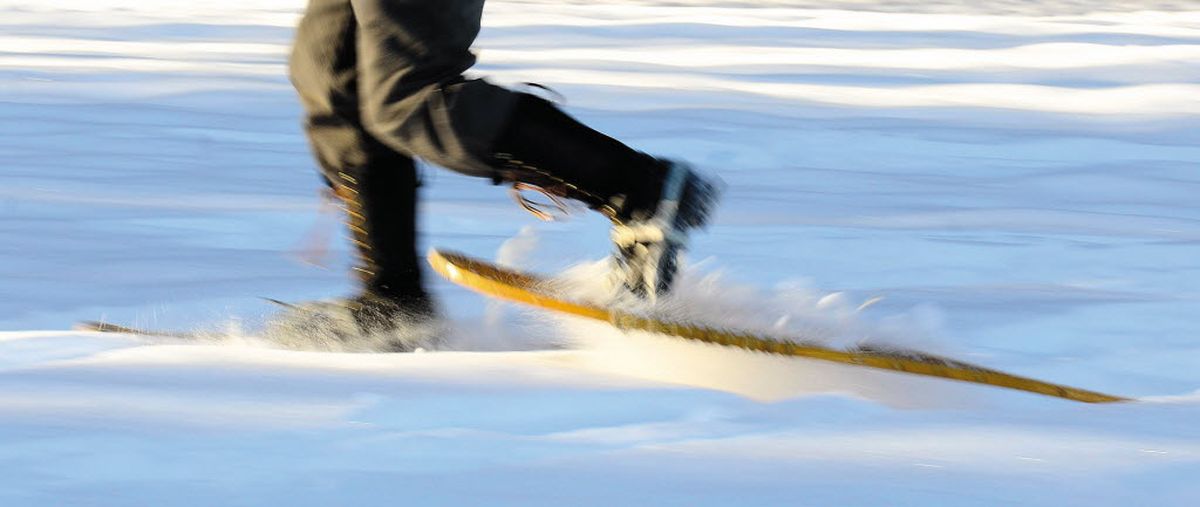Modern snowshoes light, convenient, but older ones still cool

I’m no Luddite, but I have an appreciation for the outdoor technology of yesteryear.
When deer or elk hunting, I opt for wool clothing over modern synthetics. It’s warm, even when wet, and it’s supremely quiet when I’m stalking through the woods.
I love my Winchester .30-30, lever-action rifle and my old Remington 870 Wingmaster shotgun. Not only are they practical and efficient, they are both beautiful — stylistic blends of blued metal and stained wood.
It is that kind of throwback beauty and utility that attracted me to the vintage snowshoes that had been collecting dust in my basement. The white ash frames spanned by woven rawhide are covered with layer upon layer of varnish that’s the caramel color of Scotch whiskey. The leather bindings are soft and worn with use.
My father-in-law had brought them down from Fairbanks, Alaska. The golden color and intricate woven patterns finally called to me recently after a winter storm deposited 2 feet of fresh snow in the mountains.
The classic snowshoes were wonderful. They floated so well in the sugary powder I wondered why old wood and rawhide models are rarely seen these days.
“There must be others who still love the old kind,” I thought, and started a quest to find them.
It was a lonely search. I found several people with experience using vintage snowshoes, but they had all given them up for modern versions and suggested vintage shoes are better hung over your mantel than strapped to your feet.
Dave Felkley of Nederland, Colo., compared old-school snowshoes to antique cars.
“The old Model T, if it is in good shape, is just a real piece of work and really fun, but boy, you don’t take them on a trip. They will overheat,” he said.
The beauty of wooden snowshoes makes them a great decoration, especially in a cabin or ski lodge. But Felkley, an outdoor writer who updated the late Gene Prater’s classic how-to book “Snowshoeing,” said in most conditions they don’t compare to modern models made from plastic, aluminum and synthetic fabrics for webbing.
“The performance is much better,” he said, referring to high-tech snowshoes made by companies such as Atlas, Tubbs and Mountain Safety Research. “They are far more maneuverable than the old ones.”
Mike Beiser of Moscow, Idaho, remembers using the old-style snowshoes, but not fondly. His first experience on them was in the Maine woods while studying forestry.
“That is what I used the first couple of years and probably why I detest it so much. It was an awkward process,” he said.
Beiser later became a climbing ranger for the National Park Service and then outdoor program director for the University of Idaho, where he still works. He has seen snowshoes evolve over his career. They became smaller and lighter, with claw-like crampons to make them more sure-footed on steep and icy terrains. Because of that evolution, they have become increasingly popular.
Many winter sports newbies prefer them over cross-country skis, which can be awkward for beginners. At the UI’s Outdoor Rental Center, snowshoes are a more popular item than skis.
“If you can walk, you can snowshoe,” Beiser said.
Deep powder provides the conditions in which the old snowshoes can still compete against some of the new models. The snowshoes of days gone by tended to be wider and longer than modern shoes for ultimate flotation. That also made for an awkward stride.
“You had to walk kind of funny because they were so wide,” said Al Banta of Lewiston.
Many, but not all, of the new models are short and thin by comparison. They are easier to walk in, but when the snow is exceptionally deep they can sink.
Banta had a pair of the old, wide shoes when he lived near Glacier National Park in Montana. He gave them up long ago and only wishes he had them when the snow piles high.
“There is no substitute for surface volume to get you up on top of the snow and I miss that about them,” he said.
I’ll continue to use skis for most of my winter adventures. But when the powder is bountiful, a few feet deep or more, I’ll grab the vintage shoes off the wall and go for a stroll.